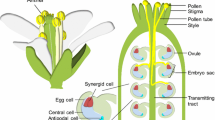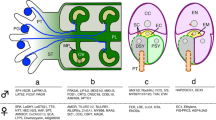Abstract
Double fertilization in angiosperm is a prerequisite for seed and fruit development and has been under close scrutiny in the past decades. Communications between male and female gametophytes are especially important in achieving successful reproduction, in which receptor-like kinases are dominant players. Here, we review progress on the functionality of receptor-like kinases (RLKs) in pollen tube growth and point out challenges facing the study of RLKs in pollen biology.

Similar content being viewed by others
References
Feng X, Zilberman D, Dickinson H (2013) A conversation across generations: soma-germ cell crosstalk in plants. Dev Cell 24:215–225
McCormick S (1993) Male gametophyte development. Plant Cell 5:1265–1275
McCormick S (2004) Control of male gametophyte development. Plant Cell 16(Suppl):S142–153
Drews GN, Yadegari R (2002) Development and function of the angiosperm female gametophyte. Annual Rev Genet 36:99–124
Sundaresan V, Alandete-Saez M (2010) Pattern formation in miniature: the female gametophyte of flowering plants. Development 137:179–189
Beale KM, Johnson MA (2013) Speed dating, rejection, and finding the perfect mate: advice from flowering plants. Curr Opin Plant Biol 16:590–597
Kessler SA, Grossniklaus U (2011) She’s the boss: signaling in pollen tube reception. Curr Opin Plant Biol 14:622–627
Shiu SH, Bleecker AB (2001) Plant receptor-like kinase gene family: diversity, function, and signaling. Sci STKE 2001:re22
Kim HU, Cotter R, Johnson S et al (2002) New pollen-specific receptor kinases identified in tomato, maize and Arabidopsis: the tomato kinases show overlapping but distinct localization patterns on pollen tubes. Plant Mol Biol 50:1–16
Muschietti J, Eyal Y, McCormick S (1998) Pollen tube localization implies a role in pollen-pistil interactions for the tomato receptor-like protein kinases LePRK1 and LePRK2. Plant Cell 10:319–330
Mu JH, Lee HS, Kao TH (1994) Characterization of a pollen-expressed receptor-like kinase gene of Petunia inflata and the activity of its encoded kinase. Plant Cell 6:709–721
Huang WJ, Liu HK, McCormick S et al (2014) Tomato pistil factor STIG1 promotes in vivo pollen tube growth by binding to phosphatidylinositol 3-phosphate and the extracellular domain of the pollen receptor kinase LePRK2. Plant Cell 26:2505–2523
Gui CP, Dong X, Liu HK et al (2014) Overexpression of the tomato pollen receptor kinase LePRK1 rewires pollen tube growth to a blebbing mode. Plant Cell 26:3538–3555
Zhang D, Wengier D, Shuai B et al (2008) The pollen receptor kinase LePRK2 mediates growth-promoting signals and positively regulates pollen germination and tube growth. Plant Physiol 148:1368–1379
Bloch D, Yalovsky S (2013) Cell polarity signaling. Curr Opin Plant Biol 16:734–742
Kost B (2008) Spatial control of Rho (Rac-Rop) signaling in tip-growing plant cells. Trends Cell Biol 18:119–127
Chang F, Gu Y, Ma H et al (2013) AtPRK2 promotes ROP1 activation via RopGEFs in the control of polarized pollen tube growth. Mol Plant 6:1187–1201
Zimmermann P, Hirsch-Hoffmann M, Hennig L et al (2004) GENEVESTIGATOR. Arabidopsis microarray database and analysis toolbox. Plant Physiol 136:2621–2632
Zhang Y, McCormick S (2007) A distinct mechanism regulating a pollen-specific guanine nucleotide exchange factor for the small GTPase Rop in Arabidopsis thaliana. Proc Natl Acad Sci USA 104:18830–18835
Zhao XY, Wang Q, Li S et al (2013) The juxtamembrane and carboxy-terminal domains of Arabidopsis PRK2 are critical for ROP-induced growth in pollen tubes. J Exp Bot 64:5599–5610
Cheung AY, Wu HM (2011) THESEUS 1, FERONIA and relatives: a family of cell wall-sensing receptor kinases? Curr Opin Plant Biol 14:632–641
Lindner H, Muller LM, Boisson-Dernier A et al (2012) CrRLK1L receptor-like kinases: not just another brick in the wall. Curr Opin Plant Biol 15:659–669
Li S, Zhang Y (2014) To grow or not to grow: FERONIA has her say. Mol Plant 7:1261–1263
Escobar-Restrepo JM, Huck N, Kessler S et al (2007) The FERONIA receptor-like kinase mediates male-female interactions during pollen tube reception. Science 317:656–660
Huck N, Moore JM, Federer M et al (2003) The Arabidopsis mutant feronia disrupts the female gametophytic control of pollen tube reception. Development 130:2149–2159
Rotman N, Rozier F, Boavida L et al (2003) Female control of male gamete delivery during fertilization in Arabidopsis thaliana. Curr Biol 13:432–436
Boisson-Dernier A, Roy S, Kritsas K et al (2009) Disruption of the pollen-expressed FERONIA homologs ANXUR1 and ANXUR2 triggers pollen tube discharge. Development 136:3279–3288
Miyazaki S, Murata T, Sakurai-Ozato N et al (2009) ANXUR1 and 2, sister genes to FERONIA/SIRENE, are male factors for coordinated fertilization. Curr Biol 19:1327–1331
Boisson-Dernier A, Lituiev DS, Nestorova A et al (2013) ANXUR receptor-like kinases coordinate cell wall integrity with growth at the pollen tube tip via NADPH oxidases. PLoS Biol 11:e1001719
Tang W, Kelley D, Ezcurra I et al (2004) LeSTIG1, an extracellular binding partner for the pollen receptor kinases LePRK1 and LePRK2, promotes pollen tube growth in vitro. Plant J 39:343–353
Wengier DL, Mazzella MA, Salem TM et al (2010) STIL, a peculiar molecule from styles, specifically dephosphorylates the pollen receptor kinase LePRK2 and stimulates pollen tube growth in vitro. BMC Plant Biol 10:33
Tang W, Ezcurra I, Muschietti J et al (2002) A cysteine-rich extracellular protein, LAT52, interacts with the extracellular domain of the pollen receptor kinase LePRK2. Plant Cell 14:2277–2287
Guyon V, Tang WH, Monti MM et al (2004) Antisense phenotypes reveal a role for SHY, a pollen-specific leucine-rich repeat protein, in pollen tube growth. Plant J 39:643–654
Endo S, Shinohara H, Matsubayashi Y et al (2013) A novel pollen-pistil interaction conferring high-temperature tolerance during reproduction via CLE45 signaling. Curr Biol 23:1670–1676
Haruta M, Sabat G, Stecker K et al (2014) A peptide hormone and its receptor protein kinase regulate plant cell expansion. Science 343:408–411
Kessler SA, Lindner H, Jones DS et al (2015) Functional analysis of related CrRLK1L receptor-like kinases in pollen tube reception. EMBO Rep 16:107–115
Berken A, Thomas C, Wittinghofer A (2005) A new family of RhoGEFs activates the Rop molecular switch in plants. Nature 436:1176–1180
Gu Y, Li S, Lord EM et al (2006) Members of a novel class of Arabidopsis Rho guanine nucleotide exchange factors control Rho GTPase-dependent polar growth. Plant Cell 18:366–381
Kaothien P, Ok SH, Shuai B et al (2005) Kinase partner protein interacts with the LePRK1 and LePRK2 receptor kinases and plays a role in polarized pollen tube growth. Plant J 42:492–503
Duan Q, Kita D, Johnson EA et al (2014) Reactive oxygen species mediate pollen tube rupture to release sperm for fertilization in Arabidopsis. Nat Commun 5:3129
Salem T, Mazzella A, Barberini ML et al (2011) Mutations in two putative phosphorylation motifs in the tomato pollen receptor kinase LePRK2 show antagonistic effects on pollen tube length. J Biol Chem 286:4882–4891
Kim S, Mollet JC, Dong J et al (2003) Chemocyanin, a small basic protein from the lily stigma, induces pollen tube chemotropism. Proc Natl Acad Sci USA 100:16125–16130
Okuda S, Tsutsui H, Shiina K et al (2009) Defensin-like polypeptide LUREs are pollen tube attractants secreted from synergid cells. Nature 458:357–361
Takeuchi H, Higashiyama T (2012) A species-specific cluster of defensin-like genes encodes diffusible pollen tube attractants in Arabidopsis. PLoS Biol 10:e1001449
Lu Y, Chanroj S, Zulkifli L et al (2011) Pollen tubes lacking a pair of K+ transporters fail to target ovules in Arabidopsis. Plant Cell 23:81–93
Li HJ, Xue Y, Jia DJ et al (2011) POD1 regulates pollen tube guidance in response to micropylar female signaling and acts in early embryo patterning in Arabidopsis. Plant Cell 23:3288–3302
Liu J, Zhong S, Guo X et al (2013) Membrane-bound RLCKs LIP1 and LIP2 are essential male factors controlling male-female attraction in Arabidopsis. Curr Biol 23:993–998
Xing HL, Dong L, Wang ZP et al (2014) A CRISPR/Cas9 toolkit for multiplex genome editing in plants. BMC Plant Biol 14:327
Liu W, Zhu X, Lei M et al (2015) A detailed procedure for CRISPR/Cas9-mediated gene editing in Arabidopsis thaliana. Sci Bull 60:1332–1347
Acknowledgments
This work was supported by the National Natural Science Foundation of China (31471304) and the Shandong Provincial Funds for Outstanding Young Scientists. Yan Zhang’s laboratory is partially supported by Tai-Shan Scholar Program of the Shandong Provincial Government. We thank Dr. Sheila McCormick for language editing.
Author information
Authors and Affiliations
Corresponding author
Ethics declarations
Conflict of interest
The authors declare that they have no conflict of interest.
Additional information
SPECIAL TOPIC: Plant Development and Reproduction
About this article
Cite this article
Chai, S., Ge, F., Li, S. et al. The journey to glory: receptor-like kinases in pollen tube growth. Sci. Bull. 61, 827–831 (2016). https://doi.org/10.1007/s11434-015-0926-5
Received:
Revised:
Accepted:
Published:
Issue Date:
DOI: https://doi.org/10.1007/s11434-015-0926-5




